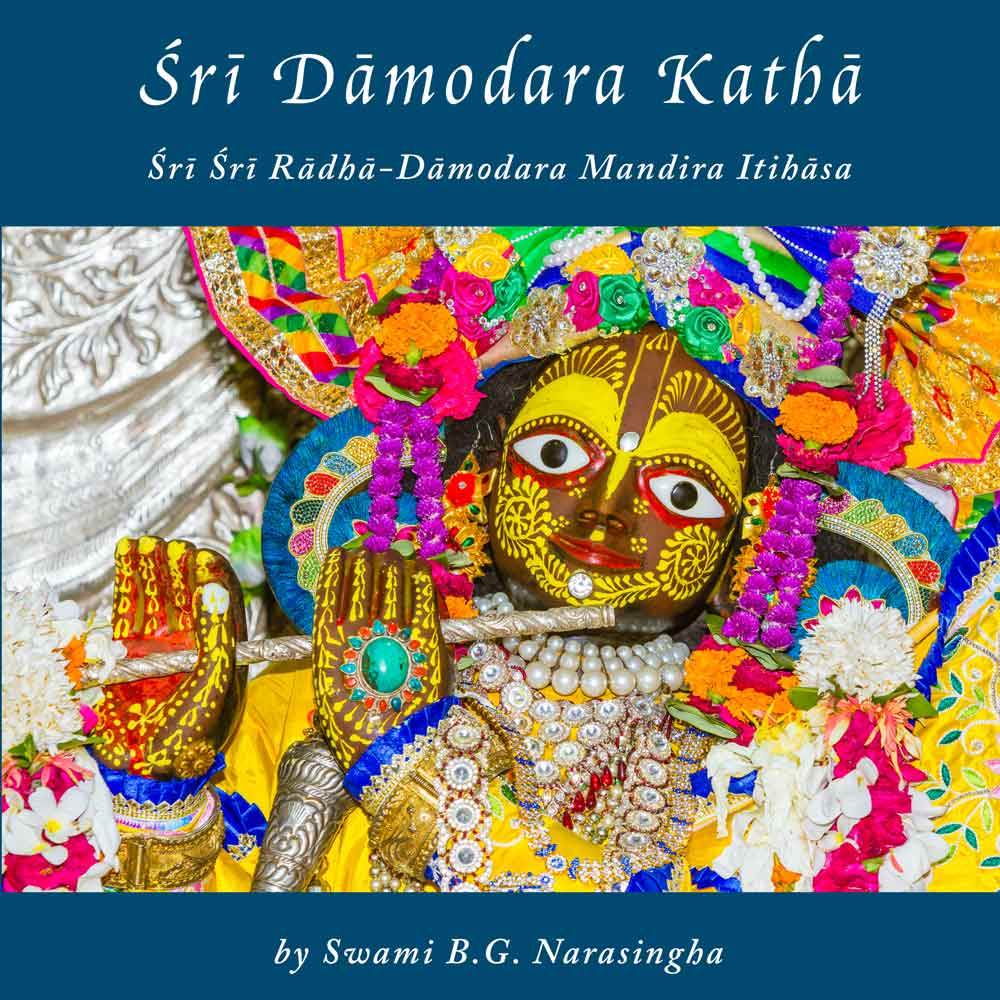Śrī Dāmodara Kathā
Śrī Mahā-mantrārtha Dīpikā by Śrīla Jīva Gosvāmī
(1)
hare kṛṣṇa hare kṛṣṇa kṛṣṇa kṛṣṇa hare hare
hare rāma hare rāma rāma rāma hare hare
sarva-ceta-hareḥ kṛṣṇas-tasya cittaṁ haratyasauḥ
vaidagdhī-sāra-vistārair-ato rādhā harā matā
“Kṛṣṇa steals the minds of everyone, yet Rādhā steals even His mind by Her divine expertise. Thus She is known as Harā.”
(2)
karṣati-svīyalāvaṇya-muralī-kala-niḥsvanaiḥ
śrī rādhāṁ mohana-guṇālankṛtaḥ kṛṣṇa iyate
“He forcibly attracts Śrī Rādhā with the sweet sound of His flute, therefore that Lord of all enchanting qualities is known as Kṛṣṇa.”
(3)
śruyate niyate rāse hariṇā hariṇekṣaṇā
ekākinī rahaḥ-kuñje hareyaṁ tena kathyate
“It has been heard that during the rasa-līlā, doe-eyed Rādhā was stolen away by Kṛṣṇa to be alone with Him in a secret forest bower. She is therefore known as Harā.”
(4)
aṅga-śyāmalima-stomaiḥ śyāmalīkṛta-kāñcanaḥ
ramate rādhayā sārdhamataḥ kṛṣṇo nigadyate
“When Kṛṣṇa sports with Rādhā, Her golden hue takes on the dark complexion of Kṛṣṇa’s skin. He is thus known as Kṛṣṇa.”
(5)
kṛtvāraṇye saraḥ śreṣṭhaṁ kāntayānumatas-tuyā
ākṛṣya sarva-tīrthāni taj-jñāṇāt kṛṣṇa iryate
“In order to please Śrī Rādhā, Kṛṣṇa manifested the most wonderful lake (Śyāma-kuṇḍa) in Vṛndāvana. He then called all the holy rivers to fill it. He is thus known as Kṛṣṇa.”
(6)
kṛṣyate rādhayā premnā yamunā-taṭa-kānanam
līlayā lalitaś-cāpi dhīraiḥ kṛṣṇa udāhṛtaḥ
“By Her unsurpassed love, Rādhā charms He who performs wonderful līlās on the banks of the Yamunā. Therefore, those who are sober know Him as Kṛṣṇa.”
(7)
hṛtavān gokule tiṣṭḥann-ariṣṭaṁ puṣṭa-puṅgavam
śrī haris taṁ rasād-uccai rāyatīti harā matā
“While in Gokula, Śrī Hari (Kṛṣṇa) killed the demon known as Ariṣṭāsura. During that time, Rādhā cried out to Him with great feeling and by doing so, She stole His mind. She is thus known as Harā.”
(8)
hyasphuṭaṁ rāyati prīti-bhareṇa hari-ceṣṭitam
gāyatīti matā dhīrair harā rasa-vicakṣaṇaiḥ
“Filled with ecstatic love, Rādhā sometimes sings the glories of Hari’s exploits quietly, and sometimes She sings them aloud. Those who are expert in the secrets of divine sentiments call Her Harā.”
(9)
rasāveśa-parisrastāṁ jahāra muralīṁ hareḥ
hareti kīrtitā devī vipine keli-lampaṭā
“Due to the intense love of Śrī Rādhā, Śrī Hari becomes so captivated that His flute falls from His hand. With the desire to enjoy in the forest bowers with Kṛṣṇa, Rādhā steals His flute. That goddess is thus famous as Harā.”
(10)
govardhana-darī-kuñje parirambha-vicakṣaṇaḥ
śrī rādhāṁ ramayāmāsa rāmastena mato hariḥ
“Kṛṣṇa, who is expert at embracing, sports with Rādhā in the forest groves or in the caves of Govardhana. Thus He is known as Rāma.”
(11)
hanti duḥkhāni bhaktānāṁ rāti saukhyati cānvaham
harā devī nigaditā mahā-kāruṇya-śālinī
“That most merciful Rādhā destroys the miseries of Her devotees and gives them great happiness every day. Therefore that goddess is known as Harā.”
(12)
ramate bhajato cetaḥ paramānanda-vāridhau
atreti kathito rāmaḥ śyāmasundara-vigrahaḥ
“The minds of the devotees are continuously drowned in an ocean of supreme joy by seeing the beautiful dark form of Kṛṣṇa. Therefore He is known by the Name Rāma.”
(13)
ramayaty-acyutaṁ premnā nikuñja-vana-mandire
rāmā nigaditā rādhā rāmo yutas tayā punaḥ
“Rādhārāṇī is known as Rāmā because She enjoys loving pastimes with Acyuta (Kṛṣṇa) in a secret forest pavilion. Since He is always by Her side, He is known as Rāma.”
(14)
rodanair gokule dāvānalam-aśayati hyasau
viśoṣāyati tenokto rāmo bhakta-sukhāvahaḥ
“When the residents of Gokula were crying due to fear of the forest fire, Kṛṣṇa immediately swallowed it and gave His devotees great joy. In this way, He is known as Rāma.”
(15)
nihantum-asurān yāto mathurā-puram ity-asau
tadāgamad-rahaḥ-kāmo yasyaḥ sā’sau hareti ca
“Śrī Kṛṣṇa went to Mathurāpurī in order to destroy the demons. However, due to being captivated by the love of Rādhā, He later returned. Therefore She is known as Harā.”
(16)
āgatya duḥkha-hartā yo sarvesāṁ vraja-vāsinām
śrī rādhā-hari-carito hariḥ śrī-nandanandanaḥ
“When the son of Mahārāja Nanda returned to Vraja, He took away the suffering of all the Vraja-vāsis. By His wonderful exploits, He steals the heart of Śrī Rādhā. Thus He is known as Hari.”


